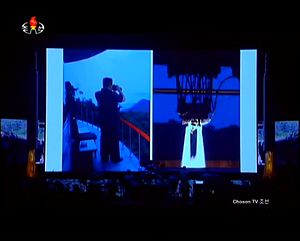North Korea, understandably, is proud of its first successful flight-test of an intercontinental-range ballistic missile (the Hwasong-14/KN-20). Accordingly, its scientists, engineers, and members of the Korean People’s Army (KPA) Strategic Rocket Forces were treated to lavish celebrations in Pyongyang. These celebrations included a massive gathering with fireworks at the capital city’s famous Kim Il-sung Square, but also a nearly two-hour long concert, featuring the well-known Moranbong Band.
Normally, these affairs are an example of the extent to which North Korea likes to pursue pageantry and showmanship to celebrate important anniversaries and achievements. Kim Jong-un had laid out the byungjin line in 2013, promising the country that he would simultaneously attain a nuclear deterrent against the United States and South Korea while providing economic growth. The over-the-top concert, available for viewing on YouTube here, serves as a reminder of Kim’s ostensible success with at least the first leg of byungjin.
Last week’s concert footage was unique for its inclusion of a slideshow featuring images of the development of North Korea’s rocket forces, going back to at least the early 1980s. The slideshow, which begins in the video linked above at around 48 minutes and 50 seconds, contains never-before-seen images of Kim Il-sung, Kim Jong-il, and Kim Jong-un inspecting a range of missile systems.
For North Korea-watchers, the images, even if only viewable through the low-resolution video released by North Korea’s state-run KCTV, are a treasure trove. (Dave Schmerler at the Center for Nonproliferation Studies has helpfully cropped and aggregated the images, which are roughly in chronological order.)
Apart from several interesting historical images, North Korea released images of the April failed flight tests of the Hwasong-14 intermediate-range ballistic missile (IRBM), confirming an earlier report in The Diplomat that the system had been tested prior to its successful flight test in May. (A recently released report (PDF) produced by the United States’ National Air and Space Intelligence Centre (NASIC) and the Defense Intelligence Ballistic Missile Analysis Committee also confirmed that the Hwasong-14 began flight-testing in April.)
The released images show evidence of at least one flight test out of Sinpo in April and another, later that month, from the Pukchang Airport area. Another image from the concert shows a Hwasong-14 IRBM on its transporter-erector inside what is presumably a fortified underground tunnel, revealing perhaps part of North Korea’s plans to improve survivability for its long-range road-mobile missiles.
Regarding the Hwasong-14/KN-20 ICBM, the concert included newly released footage of Kim surveying the preparation and fueling of the missile inside a building near the Panghyon launch site on July 4. We also may have seen, for the first time, an image of the second stage engine in the Hwasong-14, which was tested on June 22.
One image also shows Kim Jong-un standing next to separated shroud, allowing for an easy visualization of the rough size of the missile’s potential payload capacity. (It is more than large enough to fit North Korea’s suspected compact nuclear devices.) Though unverified, the concert also included a backdrop image showing at least four total Hwasong-14 missiles on transporter-erectors, suggesting that North Korea may have three additional ICBMs that could see testing later this year.
Beyond the Hwasong-12 and Hwasong-14, the images include several other curiosities, including the first released images of what looked like an ICBM-sized canister on a mobile-erector-launcher (MEL) resembling a Chinese DF-31 at the April 15 parade. Curiously, the concert slideshow did not include any images of the accompanying transporter-erector-launcher that looked like a Soviet Topol-M road-mobile ICBM launcher. Either way, that may suggest that the MEL is under development while the canistered TEL is not.
The image series also included the first known images of North Korea’s WS51200 heavy logging trucks in their original Chinese forestry paint job; North Korea would later convert these trucks to carry its heavy, long-range ballistic missiles, including the KN-08 and KN-14 ICBMs and, most recently, the Hwasong-14/KN-20 ICBM.
The above reflections offer just a glimpse at what North Korea showed off with more than 190 images, most of which are newly revealed. In the coming days, weeks, and months, analysts will be poring over these to glean more insights into where North Korea’s ballistic missile program has been and where it may be going in the future.
































